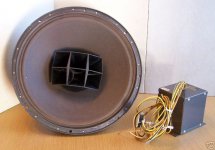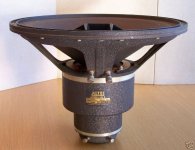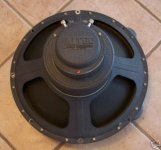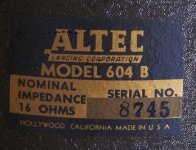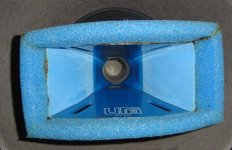SunRa said:
Regarding the plasma tweeter, I was actualy thinking at this one here: Acapella Violon
What I've read about ion tweeters indicates that they cant have much headroom by priciple.
Exclusive! The History of a Brilliant Failure by Daniel Schoo
http://www.ionovac.com/dshistory1.htm
Havent heard any Acapellas or other plasma speakers on horns, but would doubt if they can keep up - SPL wise - with the conventional mid horns as claimed
When I auditioned the omnidirectional Magnat plasma speaker it was at rather modest levels.
Greetings
Michael
Yup, plasma tweeters are having some really big problems in terms of SPL and ozone emission. I corresponded some time ago with an Italian inventor claiming he resolved the second problem by changing the frequency the oscillator circuit was working. He also used mosfets not tubes.
I dunno how the first problem can be resolved. How do you make the system more efficient? Increasing the temperature of the "flame"? And to what extent? I guess that when heating air some non-linearities will finally start to show-up.
I dunno how the first problem can be resolved. How do you make the system more efficient? Increasing the temperature of the "flame"? And to what extent? I guess that when heating air some non-linearities will finally start to show-up.
Lynn.. or John A if you are there ...
Have you got any tips & tricks for reaching John Atwood ?
I fear his 'guilty until proved innocent' spam filter may be stopping me reaching him on the one-electron email .
I would very much like to contact on how his own evaluations of the GPA 288-H are going , and other general speaker observations .
I'm on the usual Qioptiq email as on your mailing list .
Cheers,
Mark
Have you got any tips & tricks for reaching John Atwood ?
I fear his 'guilty until proved innocent' spam filter may be stopping me reaching him on the one-electron email .
I would very much like to contact on how his own evaluations of the GPA 288-H are going , and other general speaker observations .
I'm on the usual Qioptiq email as on your mailing list .
Cheers,
Mark
Altec Duplex
*
Years ago, when I was just a kid, I had an Altec duplex in my hifi system. It was a 604b, a late 1940's model--with alnico and multicellular horn. Back then I knew nothing about alnico, or about compression drivers; I only knew that my Altec looked cooler and sounded better than anything else I had come across.
So it's interesting to see Hiraga's beautiful system using a horn that looks identical to the Altec 604b horn, which had six cells. Mmmm....I wonder if a 604 with multicellular horn (and alnico!) can be ordered from GPA! And I wonder why Altec dropped the multicellular horn...to cut costs?
Here's a photo of a mint 604b that sold last year.
*
As far as I know, the Hiraga 604 is the series II from GPA (ferrite) with a multicellular horn that he adds himself.
Years ago, when I was just a kid, I had an Altec duplex in my hifi system. It was a 604b, a late 1940's model--with alnico and multicellular horn. Back then I knew nothing about alnico, or about compression drivers; I only knew that my Altec looked cooler and sounded better than anything else I had come across.
So it's interesting to see Hiraga's beautiful system using a horn that looks identical to the Altec 604b horn, which had six cells. Mmmm....I wonder if a 604 with multicellular horn (and alnico!) can be ordered from GPA! And I wonder why Altec dropped the multicellular horn...to cut costs?
Here's a photo of a mint 604b that sold last year.
Attachments
The new 604-8h-III uses a UREI style horn. There are pics of it over at Audio Asylum and at the Altec hostboard site.
I have a pair on order, but don't have anything to show for it yet. I was inspired by the sound of the Shindo Latour when I heard it at Pitch Perfect.
Chris
I have a pair on order, but don't have anything to show for it yet. I was inspired by the sound of the Shindo Latour when I heard it at Pitch Perfect.
Chris
Robh3606,
You will need to tell me which one it is most like...as it is a bi-radial horn, but I don't think it is a copy of any of the old ones.
http://www.audioasylum.com/cgi/vt.mpl?f=hug&m=135848
http://www.hostboard.com/cgi-bin/ultimatebb.cgi/ubb/get_topic/f/3729/t/3812
Either way, it is different and more spendy than the Mantaray.
Chris
You will need to tell me which one it is most like...as it is a bi-radial horn, but I don't think it is a copy of any of the old ones.
http://www.audioasylum.com/cgi/vt.mpl?f=hug&m=135848
http://www.hostboard.com/cgi-bin/ultimatebb.cgi/ubb/get_topic/f/3729/t/3812
Either way, it is different and more spendy than the Mantaray.
Chris
flying a speaker
Although we do not hear too much from Lynn I assume his project to be in good progress.
As most likely it develops step by step towards a real world something, I would like to come back to what was hardly touched yet in this thread (LOL at #4000+) and present some additional thoughts about interesting aspects when considering variants to keep a speaker in place.
As I mentioned earlier, flying is a simple alternative to bolt a speaker to a rigid structure, though not very common in home-fi.
To explore this some further and put things into perspective lets do quick calculation.
Lets keep things simple and lets therefor take a speaker with a total mass of 10kg and a membrane mms of 10g.
Lets further assume the peak force from the motor of that speaker to the membrane to be 10 Newton.
Given the above, the membrane will move a certain amount depending on frequency.
Now lets imagine the speaker being in outer space.
The force produced by the motor will not only move the membrane towards one direction but also will move the speaker towards the opposite direction.
The ratio of movement is determined simply by the ratio of masses.
In our example the speaker will move 1/1000 the excursion of the membrane – the ratio of 10g to 10kg.
Without too much penalty exactly the same applies when hooking a real world speaker by a string!
If we calculate the membrane excursion from a sinus force of 10N (peak) to a 10g membrane mass, at 150Hz. we roughly get 1mm one way excursion of the membrane and 0,001mm excursion of the speaker.
At 1500Hz we would get 0,01mm excursion of the membrane and 0,00001mm excursion of the speaker.
Just remember:
a constant force over frequency from the motor – in case of an ideal speaker - means the same current flow through the voice coil and it also means a constant SPL over frequency for any frequencies way above resonance at least!
Now we come to the most interesting part – comparing the two alternatives.
Variant one (speaker bolt to a ideal rigid structure):
It is easy to imagine that if the speaker is bolt to a ideal rigid structure than this structure has to withstand the 10N peak over the whole frequency range. NO excursion of the speaker would (ideally) happen then.
Variant two (flying the speaker):
If the speaker is hooked by a string of lets say 100mm the (sinus- ) horizontal force can be calculated without too much error by the ratio of string length to excursion multiplied by the weight of the speaker.
In case of 150Hz we already calculated a excursion of the speaker of 0,001mm which translates into a peak horizontal force at the hook of about 1 Newton
In case of 1500 Hz we get a peak horizontal force the structure behind the hook has to withstand of 0,01 N.
Bottom line:
given the above example – which easily could apply to a midrange speaker – we can achieve a force attenuation of 20 dB at 150Hz and of 60dB at 1500Hz to whatever structure we'd like to build by rather flying the speaker than bolt it down.
Well, this is quite something – no?
Greetings
Michael
PS:
I'd go nuts to do all this calculations in imperial system

Although we do not hear too much from Lynn I assume his project to be in good progress.
As most likely it develops step by step towards a real world something, I would like to come back to what was hardly touched yet in this thread (LOL at #4000+) and present some additional thoughts about interesting aspects when considering variants to keep a speaker in place.
As I mentioned earlier, flying is a simple alternative to bolt a speaker to a rigid structure, though not very common in home-fi.
To explore this some further and put things into perspective lets do quick calculation.
Lets keep things simple and lets therefor take a speaker with a total mass of 10kg and a membrane mms of 10g.
Lets further assume the peak force from the motor of that speaker to the membrane to be 10 Newton.
Given the above, the membrane will move a certain amount depending on frequency.
Now lets imagine the speaker being in outer space.
The force produced by the motor will not only move the membrane towards one direction but also will move the speaker towards the opposite direction.
The ratio of movement is determined simply by the ratio of masses.
In our example the speaker will move 1/1000 the excursion of the membrane – the ratio of 10g to 10kg.
Without too much penalty exactly the same applies when hooking a real world speaker by a string!
If we calculate the membrane excursion from a sinus force of 10N (peak) to a 10g membrane mass, at 150Hz. we roughly get 1mm one way excursion of the membrane and 0,001mm excursion of the speaker.
At 1500Hz we would get 0,01mm excursion of the membrane and 0,00001mm excursion of the speaker.
Just remember:
a constant force over frequency from the motor – in case of an ideal speaker - means the same current flow through the voice coil and it also means a constant SPL over frequency for any frequencies way above resonance at least!
Now we come to the most interesting part – comparing the two alternatives.
Variant one (speaker bolt to a ideal rigid structure):
It is easy to imagine that if the speaker is bolt to a ideal rigid structure than this structure has to withstand the 10N peak over the whole frequency range. NO excursion of the speaker would (ideally) happen then.
Variant two (flying the speaker):
If the speaker is hooked by a string of lets say 100mm the (sinus- ) horizontal force can be calculated without too much error by the ratio of string length to excursion multiplied by the weight of the speaker.
In case of 150Hz we already calculated a excursion of the speaker of 0,001mm which translates into a peak horizontal force at the hook of about 1 Newton
In case of 1500 Hz we get a peak horizontal force the structure behind the hook has to withstand of 0,01 N.
Bottom line:
given the above example – which easily could apply to a midrange speaker – we can achieve a force attenuation of 20 dB at 150Hz and of 60dB at 1500Hz to whatever structure we'd like to build by rather flying the speaker than bolt it down.
Well, this is quite something – no?
Greetings
Michael
PS:
I'd go nuts to do all this calculations in imperial system
sorry I have to correct my last posting - just slipped into the wrong row (the one of membrane excursion instead of speaker excursion) in my spreadsheet
the last part should have been:
###################
Variant two (flying the speaker):
If the speaker is hooked by a string of lets say 100mm the (sinus- ) horizontal force can be calculated without too much error by the ratio of string length to excursion multiplied by the weight of the speaker.
In case of 150Hz we already calculated a excursion of the speaker of 0,001mm which translates into a peak horizontal force at the hook of about 0,001 Newton (100N of speaker weight multiplied by 0,001/100mm)
In case of 1500 Hz we get a peak horizontal force the structure behind the hook has to withstand of 0,00001 N.
Bottom line:
given the above example – which easily could apply to a midrange speaker – we can achieve a force attenuation of around 80 dB at 150Hz and of around 120 dB at 1500Hz to whatever structure we'd like to build by rather flying the speaker than bolt it down.
#####################
Well, even better now – no?
Thanks!
Greetings
Michael
the last part should have been:
###################
Variant two (flying the speaker):
If the speaker is hooked by a string of lets say 100mm the (sinus- ) horizontal force can be calculated without too much error by the ratio of string length to excursion multiplied by the weight of the speaker.
In case of 150Hz we already calculated a excursion of the speaker of 0,001mm which translates into a peak horizontal force at the hook of about 0,001 Newton (100N of speaker weight multiplied by 0,001/100mm)
In case of 1500 Hz we get a peak horizontal force the structure behind the hook has to withstand of 0,00001 N.
Bottom line:
given the above example – which easily could apply to a midrange speaker – we can achieve a force attenuation of around 80 dB at 150Hz and of around 120 dB at 1500Hz to whatever structure we'd like to build by rather flying the speaker than bolt it down.
#####################
Well, even better now – no?
Variac said:Very interesting!
Thanks!
Greetings
Michael
- Home
- Loudspeakers
- Multi-Way
- Beyond the Ariel
